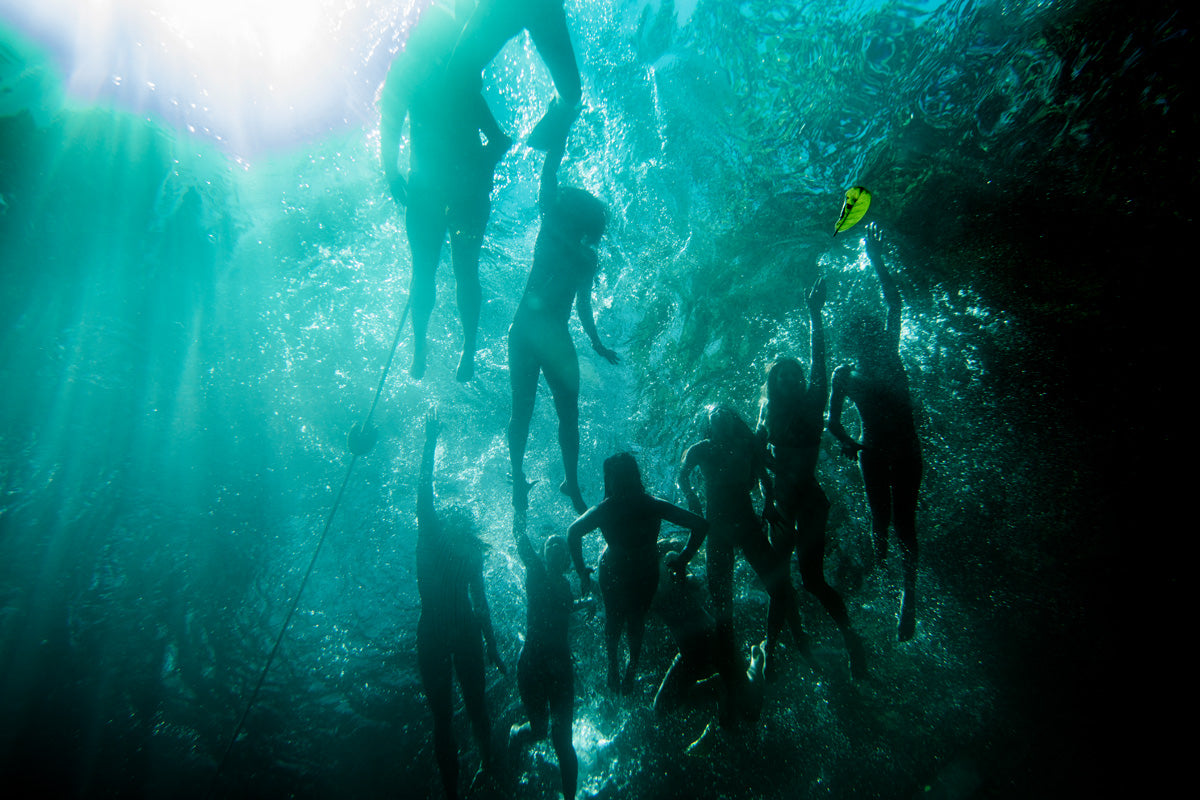As of 2018, all of Seea’s wetsuit range is neoprene free. We’re replacing neoprene with plant-based Yulex technology because we believe in choosing sustainable and ethically sound materials whenever possible. Better yet, Yulex performs excellently in warmth, comfort, stretch, and durability.
As surfers that adore our ocean playground, it’s ironic that our primary tools—wetsuits and surfboards (and plastics) made from petroleum products—are major contributors to emissions that cause climate change. Lucky for us, Patagonia pioneered the transition to plant-based Yulex, and generously made Yulex technology available to other brands (like ours!).
Seea Ambassador Lauren L. Hill.
The application of Yulex to wetsuits is an important victory in materials innovation for our surfing culture, posting an option for reducing our dependence on petroleum without sacrificing warmth or performance.
Seea ambassador and environmental activist Lauren Hill walks us through a brief history of neoprene and why it’s become more important than ever to make choices that protect natural resources.
By Lauren L. Hill
We are lucky to be surfers in this century, for a million reasons, and the wetsuit is definitely one of them. The luxury of warmth meant surfing could grow far beyond the more temperate coasts of Polynesia, Australia, or California, to the iciest edges of any ocean.
For the last 60 years wetsuits have been constructed of petroleum or limestone based neoprene. As demand and prices soared for natural rubber through the roaring and warring 1920s, neoprene was synthesized (in 1930) as a cheaper synthetic alternative. The Dupont company patented the formula for neoprene (formerly Duprene), and that formula has basically been unchanged since the early 1950s. Around 300,000 tons of neoprene are produced worldwide every year.[1]
So, why ditch neoprene?
Because when we know better, we can do better.
The problems of neoprene:
- What is it made from
- How it is made
Making this petroleum-based material comes at a huge environmental and human cost. We know that producing neoprene contributes to climate change and that the toxic gasses emitted in the chemical processing plants cause cancer [2].
“Neoprene is most commonly made by chlorinating and polymerizing butadiene, a petrochemical refined from crude oil.[3]" From oil extraction to conversion to polychloroprene rubber chips, the process of producing neoprene requires lots of energy. Both petroleum and limestone are nonrenewable resources; when they run out, there’s no more.[4]
While limestone neoprene has been touted as a “greener” alternative, the process of converting limestone to neoprene is still a highly energy intensive (read: C02 polluting) process and relies on questionable mining practices.
Is limestone neoprene less energy-intensive to make than petroleum-based neoprene? Yes.
Is it the most sustainable option on the market? No.

What is Yulex?
“Now imagine a plantation or forest, say in the highlands of Sri Lanka, where rubber trees are tapped gently using coconut husk and the skills of a local person wielding a machete,” Patagonia ambassador and long-time pro freesurfer Dave Rastovich explains. While we were travelling in Sri Lanka a couple of years ago, Dave snuck off to the highlands to document the supply chain of Patagonia’s newest wetsuit innovation, Yulex.
When he returned to the dusty coastal scrub of the East Coast, Dave raved about the working conditions and slow processing that was so different from what he’d imagined raw material processing could be like.
“Under the cool shade of the havea canopy, it was obvious how much more gentle on local community and ecology the Yulex process is compared to traditional petroleum-based rubbers,” Dave explained. “It was great to see local men and women with their kids beside them tapping rubber trees that can produce for more than 30 years. I haven’t literally been to an oil rig or well, but it doesn’t take much imagination to see how vastly different the processes and consequences are ecology and culture.”
As surfers we have this reputation for being inherently environmentalist because of our proximity and intimacy with the ocean. But our industry couldn’t be further from it. Dave and I both have spent decades working in and around the surfing industry, trying to interject small environmental initiatives and pushing for the companies we’ve worked with to use more sustainable materials. Wins have been modest and lasting change mostly elusive. There’s so much marketing spin that clouds the realities of clothing and wetsuit production.
But it finally seems like we’ve come to the kind of critical mass that can make for lasting change, with companies like Patagonia and Seea taking the idea of environmental responsibility – and the pursuit of constantly reassessing social and environmental impact – to the mainstream. This is about normalizing principles like fair trade, FSC certification, and doing better when we know better options are available. Yulex is one of many chances for our industry and culture to take a collective stand and do better than continuing our dependence on petroleum.
Sometimes moving forward means looking back for sparks of inspiration that died out too soon. Natural rubber was used in the ancient world amongst the Aztec and Maya more than 3,000 years ago. And natural rubber wetsuits were being produced in Europe during the 1950s.
Natural rubber, or latex, is harvested from Hevea trees. While hevea plantations are historically linked with deforestation due to monocultural farming practice, Yulex works solely with FSC (Forest Stewardship Council) certified hevea producers as determined by the Rainforest Alliance. This means that the hevea farmers commit to stringent social and environmental guidelines for responsible forest management.
To harvest rubber, thin incisions are skillfully made in the bark of hevea trees, from which thick, milky latex drains into little catchment vessels. The latex is then spun in centrifuges to remove its 70% water content. The wobbly blocks of solidified latex are then shipped to the folks at Yulex for their patented water-based purification process (as opposed to the chemical refining of neoprene that creates chemical waste), to remove 99% of impurities, including the protein responsible for latex allergy.
The purified natural rubber is then mixed with 15% synthetic rubber to bolster the blend’s stretch, durability and UV protection. The rubber is then processed into sheets lined with recycled polyester and elastane and laminated onto the rubber with AQUA water-based, solvent-free lamination glue. Wetsuits are then cut from these sheets.
“Using natural rubber in place of energy-intensive neoprene means up to ~80% less climate-altering CO2 is emitted in the polymer manufacturing process.[5]”
We’re never going to buy ourselves out of the climate crisis. But small shifts in our purchasing power can make real and meaningful impacts in altering the way the fashion industry—and our surfing culture—does business.
--
To Shop the current Seea wetsuit collection featuring Yulex, click HERE.
To find out more about how Seea is working towards reducing our environmental impact, click HERE.
Footnotes:
[1] American Chemistry Council
[2] https://www.cnn.com/2017/10/20/health/louisiana-toxic-town/index.html
[3] https://www.patagonia.com/yulex.html
[4] https://issuu.com/thecleanestline/docs/patagonia-the-future-of-wetsuits?e=1043061/38029799
[6] https://www.patagonia.com/yulex-natural-rubber-wetsuits.html








